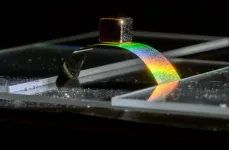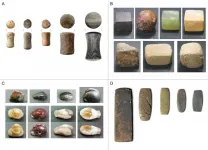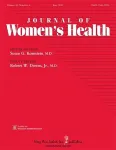INFORMATION:
The research team is now developing the plans for the clinical trial. They are based at the Zayed Centre for Research into Rare Disease in Children, which is a partnership between GOSH, UCL, and GOSH Charity. They hope the clinical trial will launch at GOSH - an international recognised centre of excellence in neurotransmitter disorders - in 2022.
All research at Great Ormond Street Hospital NHS Foundation Trust is made possible by the NIHR Great Ormond Street Hospital Biomedical Research Centre.
This work was supported by the National Institute for Health Research, contributing only to work in human cells.
Gene therapy breakthrough offers hope to children with rare and fatal brain disease
2021-06-29
(Press-News.org) Scientists and doctors at University College London Great Ormond Street Institute of Child Health (UCL GOS ICH) and Great Ormond Street Hospital (GOSH) have given hope of a gene therapy cure to children with a rare degenerative brain disorder called Dopamine Transporter Deficiency Syndrome (DTDS).
The team have recreated and cured the disease using state-of-the-art laboratory and mouse models of the disease and will soon apply for a clinical trial of the therapy. Their breakthrough comes just a decade after the faulty gene causing the disease was first discovered by the lead scientist of this work.
The results, published in Science Translational Medicine, are so promising that the UK regulatory agency MHRA has advised the researchers that they can now proceed to prepare for a clinical trial. DTDS is a rare, progressive and life-limiting neurological condition caused by a faulty gene that affects brain cells. Infants with DTDS are rarely able to learn to walk or speak and as they grow they develop 'parkinsonism', so called because of similarities to Parkinson's Disease.
This includes slow movements, involuntary twisting postures of their arms and legs and whole-body stiffness.
There are no effective treatments or a cure and most children with DTDS sadly die before reaching adulthood, often from respiratory infections or other complications. Although the condition is rare, with around 50 children worldwide currently known to doctors, it has previously been mistaken for cerebral palsy and may continue to be undiagnosed.
Professor Manju Kurian discovered the faulty gene causing DTDS in 2009 and was subsequently granted seed funding worth just over £86,500 from Great Ormond Street Hospital Children's Charity (GOSH Charity) to begin developing the treatment. Professor Kurian's team and her collaborators at UCL have also spent the last decade working to better understand the mechanisms that underpin this disease, and this has enabled them to develop a new, precision gene therapy with the potential to treat this devastating disorder.
How the precision gene therapy works
Scientists took skin cells from children with DTDS and turned them into stem cells, which can grow into any type of cell to build or repair different parts of the body. Professor Kurian's team, with work led by Dr Serena Barral, converted these stem cells into the exact brain cells (dopaminergic neurons) that carry the genetic 'fault' responsible for DTDS.
Using this laboratory model - or 'disease in a dish' - made directly from the cells of children with this rare condition, scientists were able to test the experimental gene therapy for DTDS and show that it could relieve the disease-related defects in DTDS brain cells.
The team used fluorescence microscopy to see what was happening in their 'disease in a dish'. The seemingly random pattern of colours in the untreated cells (left) shows how the neurons and their communicating 'arms' - called neurites - had not formed properly in cells with DTDS. The gene therapy treated cells form a much more obvious cluster pattern for the neuron - seen in white - with its red neurites, essentially showing the DTDS is cured in a laboratory model.
A further collaboration with UCL's Professor Simon Waddington and Dr Joanne Ng enabled the researchers to build on their 'disease in a dish' results, studying DTDS in mice and testing gene therapy as a cure. The gene therapy injects a modified, harmless virus containing the healthy gene into the area of the brain where this gene is missing. The mice were successfully cured of their symptoms including involuntary and disordered movements, progressive parkinsonism and weightloss. Based on the promising results of the laboratory tests, the next phase is to develop a clinicaltrial which would involve children diagnosed with DTDS.
22-year-old Shannon from Cornwall was one of the first patients diagnosed with DTDS after Professor Kurian discovered the faulty gene in 2009. Her mum, Judith said: "Shannon is a happy, bubbly girl and finds everything hilarious. DTDS meant Shannon suffered badly from shakes - she couldn't control her legs. She shakes very slightly now, but it's very mild."
On Shannon being one of the first patients in whom the faulty gene was discovered, Judith said, "It's amazing. The last time we saw Professor Kurian she said there had been a breakthrough with the research, but it hadn't been tried on anyone yet.
"GOSH is a brilliant hospital and I donate to the charity every month to help keep the extra support at the hospital going."
Professor Manju Kurian, Consultant Paediatric Neurologist at GOSH and NIHR Research Professor at UCL Great Ormond Street Hospital Institute of Child Health, co-lead author on this study and the scientist behind the discovery of this disease: "Our study provides real hope of an effective treatment for children who are living with this devastating, life-limiting brain disease, and it is hugely exciting to be at the stage of planning a clinical trial just ten years after discovering the gene that causes the condition.
"We hope this pioneering gene therapy will prevent the progression of this rare but cruel disease with a single procedure, giving children the improved quality and length of life that they deserve. If we can use gene therapy to treat children with this condition early enough, there is great potential for improvement in their health.
"We're hugely grateful to our funders including GOSH Charity who supported our research at the very beginning, as well as the Wellcome Trust, MRC, John Black Charitable Foundation, Robert Luff Foundation and Rosetrees for their investment; without their support we wouldn't be within touching distance of delivering a breakthrough cure that these children so desperately need."
Professor Simon Waddington, Professor of Gene Therapy at UCL, co-lead author on this study:
"Our whole working process has been guided by one principle: we want to find the answers for these children and how we can treat them. "The mice received the same carefully selected vector and delivery route that we plan to use in
treating the children. This careful selection has allowed us to progress rapidly to design a protocol so we can start the clinical trial next year.
"While DTDS is rare, we know that there are many other conditions we can model in this way, opening the door for a standardised approach to finding cures for these rare conditions."
Dr Kiki Syrad, Director of Grants and Impact at GOSH Charity, which provided funding early in the development of this treatment said: "At GOSH Charity we fund paediatric research to aid the discovery of desperately needed new treatments and cures for children living with rare diseases.
"We are absolutely delighted to see the progress that this study publication points to. It offers the hope of an effective treatment which could be nothing short of lifechanging for children and families living this with this rare, devastating condition. This is the hope that paediatric rare disease research can offer, and that's why we will continue to invest in trail-blazing projects such as this."
ELSE PRESS RELEASES FROM THIS DATE:
New Geology articles published online ahead of print in June
2021-06-29
Boulder, Colo., USA: Article topics include the Great Unconformity of the
Rocky Mountain region; new Ediacara-type fossils; the southern Cascade arc
(California, USA); the European Alps and the Late Pleistocene glacial
maximum; Permian-Triassic ammonoid mass extinction; permafrost thaw; the
southern Rocky Mountains of Colorado (USA); "gargle dynamics"; invisible
gold; and alluvial fan deposits in Valles Marineris, Mars. These Geology articles are online at
https://geology.geoscienceworld.org/content/early/recent
.
A new kind of invisible gold in pyrite hosted in deformation-related
dislocations
Denis Fougerouse; Steven M. Reddy; Mark ...
Growing 'metallic wood' to new heights
2021-06-29
Natural wood remains a ubiquitous building material because of its high strength-to-density ratio; trees are strong enough to grow hundreds of feet tall but remain light enough to float down a river after being logged.
For the past three years, engineers at the University of Pennsylvania's School of Engineering and Applied Science have been developing a type of material they've dubbed "metallic wood." Their material gets its useful properties and name from a key structural feature of its natural counterpart: porosity. As a lattice of nanoscale nickel struts, metallic wood is full of regularly spaced cell-sized pores that radically decrease its density without sacrificing the material's ...
Bronze Age: how the market began
2021-06-29
Knowing the weight of a commodity provides an objective way to value goods in the marketplace. But did a self-regulating market even exist in the Bronze Age? And what can weight systems tell us about this? A team of researchers from the University of Göttingen researched this by investigating the dissemination of weight systems throughout Western Eurasia. Their new simulation indicates that the interaction of merchants, even without substantial intervention from governments or institutions, is likely to explain the spread of Bronze Age technology to weigh goods. The results were ...
In with the old, out with the mew
2021-06-29
Keep your checklists handy because the 62nd Supplement to the American Ornithological Society's Check-list of North American Birds, publishing today in Ornithology, includes numerous updates to the classification of the continent's bird species. A few highlights from this year's supplement, detailed below, include species splits for Mew Gull, Barred Owl, and Sedge Wren, among quite a few others; a transfer back to an old genus for Ruby-crowned Kinglet; and a revision of the linear sequence of passerine families. The Check-list, published since 1886, is updated annually by the AOS's North American Classification Committee (NACC), the official authority on the names and ...
Longer-lived lithium-metal battery marks step forward for electric vehicles
2021-06-29
RICHLAND, Wash.--Researchers have increased the lifetime of a promising electric vehicle battery to a record level, an important step toward the goal of lighter, less expensive and long-lasting batteries for future electric vehicles. The work is reported June 28 in the journal Nature Energy.
Such batteries--the goal of research groups the world over--are seen as an important part of the solution to reduce the effects of climate change, and scientists are exploring a dizzying array of options.
One solution on the horizon is a lithium-metal battery for electric vehicles. These ...
UTSA study: Use of police force still breaking down across racial, ethnic lines
2021-06-29
(San Antonio, June 29, 2021) - UTSA criminology and criminal justice professors Michael R. Smith and Rob Tillyer working in collaboration with University of Cincinnati Professor Robin Engel examined racial and ethnic disparities in the use of force by the Fairfax County Police Department (FCPD). One of the nation's largest county police departments, the FCPD serves Fairfax County, Va., a major metropolitan county near Washington, D.C.
The team presented the results of its 18-month study today to the Public Safety Committee of the Fairfax County Board of Supervisors. ...
To understand the future of hurricanes, look to the past
2021-06-29
The historic 2020 hurricane season, with its record-breaking 30 tropical storms and hurricanes, left in its wake hundreds of deaths in the United States, tens of billions of dollars in damages, and one important question: Is this what the future will look like?
While most climate scientists agree that hurricane severity, at least in terms of rainfall, will likely increase as the planet warms, there remains uncertainty about the future frequency of hurricanes. Today's climate models offer a range of possible futures, some predicting an increase in North Atlantic hurricane frequency, others a decrease. These conflicting results beg the question: are these ...
Fungi embrace fundamental economic theory as they engage in trading
2021-06-29
HOUSTON - (June 29, 2021) - When you think about trade and market relationships, you might think about brokers yelling at each other on the floor of a stock exchange on Wall Street. But it seems one of the basic functions of a free market is quietly practiced by fungi.
New research from a Rice University economist suggests certain networks of fungi embrace an important economic theory as they engage in trading nutrients for carbon with their host plants. This finding could aid the understanding of carbon storage in soils, an important tool in mitigating climate change.
A research paper entitled "Walrasian equilibrium behavior in nature" is available online and will appear in an upcoming edition of Proceedings of the National Academy of Sciences. Ted Loch-Temzelides, ...
Financial barriers to cervical cancer screening
2021-06-29
Among low-income, uninsured, or publicly insured women ages 25-64 years who were not up to date on cervical cancer screening, 72% perceived financial barriers to screening. The most commonly reported barriers were screening appointment costs (71%) and follow-up/future treatment costs (44%), according to a study published in the peer-reviewed Journal of Women’s Health. Click here to read the article now.
Screening is effective at reducing the incidence of and mortality associated with cervical cancer. However, disparities exist in cervical cancer incidence and mortality and in cervical cancer screening based ...
A promising two-punch therapy for Langerhans cell histiocytosis
2021-06-29
Langerhans cell histiocytosis (LCH) is a rare cancer involving dendritic cells, a type of white blood cell that usually helps defend against infections. The current standard of care for LCH, chemotherapy, cures fewer than half of patients.
"Our research team focuses on identifying the causes of LCH so that we can develop better therapies for patients," said Dr. Rikhia Chakraborty, assistant professor of pediatrics - hematology and oncology at Baylor College of Medicine.
Most cells in LCH lesions are not abnormal dendritic cells but other invading immune cells, such as T cells, that are recruited to sites of disease. The contribution of T cells and other immune cells to LCH disease is not known. Chakraborty and her team at the Texas Children's Cancer Center Histiocytosis Program characterized ...



